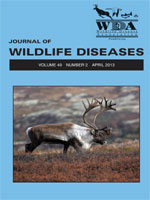European Starlings (Sturnus vulgaris) and House Sparrows (Passer domesticus) are common peridomestic passerine birds that are often associated with domestic animal production facilities. This association provides a potential means for pathogen transmission between facilities. We inoculated European Starlings and House Sparrows with three nonavian influenza virus strains: two swine isolates (H1N1 and H3N2) and one human isolate representing the H1N1 pandemic strain that originated from swine. No viral shedding was observed in House Sparrows, and shedding was minimal and transient in two of 12 (17%) European Starlings. One of these two infected Starlings seroconverted 14 days after inoculation. These results suggest that these two passerine species are minimally susceptible to current influenza viruses in domestic pigs and therefore pose a negligible risk for transmission between or within swine production facilities.
How to translate text using browser tools
1 April 2013
Experimental Infection of European Starlings (Sturnus vulgaris) and House Sparrows (Passer domesticus) with Pandemic 2009 H1N1 and Swine H1N1 and H3N2 Triple Reassortant Influenza Viruses
Nicole M. Nemeth,
Paul T. Oesterle,
Rebecca L. Poulson,
Cheryl A. Jones,
S. Mark Tompkins,
Justin D. Brown,
David E. Stallknecht
ACCESS THE FULL ARTICLE

Journal of Wildlife Diseases
Vol. 49 • No. 2
April 2013
Vol. 49 • No. 2
April 2013
European Starling
house sparrow
pandemic H1N1 influenza virus
Passer domesticus
passerines
Sturnus vulgaris
swine influenza virus




